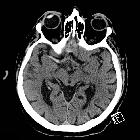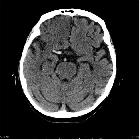Hyperdense MCA sign (brain)














The hyperdense MCA sign refers to focal hyperdensity of the middle cerebral artery (MCA) on non-contrast brain CT and is the direct visualization of thromboembolic material within the lumen. It is thus the earliest visible sign of MCA infarction as it is seen within 90 minutes after the event . It is the longitudinal equivalent of the MCA dot sign and hyperdense basilar tip sign.
Pathology
The hyperdensity of the arterial content is due to the thrombus having previously formed and contracted, usually within the heart or carotid bulb, prior to embolizing and occluding the MCA.
Sensitivity and specificity
The sensitivity of this CT sign is approximately 30%, while its specificity is high reaching 90% .
Radiographic features
CT
The proximal portion of the MCA, often extending into the terminal supraclinoid internal carotid artery, is hyperdense compared to the other side and to the basilar tip which is often at a similar level.
Care must be taken not to overcall this sign on thick axial slices only as different slice position relative to the MCA can lead to asymmetry. Review of thin-section CT and multiplanar reformats is usually able to confirm it as a true finding.
Treatment and prognosis
A long hyperdense MCA, greater than 8 mm, portends no chance of recanalization after intravenous thrombolysis . However, poor prognosis is by no means established in light of recent intraarterial thrombectomy techniques.
Differential diagnosis
Usually, there is no differential diagnosis, as the clinical context is consistent with ipsilateral middle cerebral artery occlusion.
Occasionally, a similar appearance may be the result of calcified atherosclerotic disease. High hematocrit (e.g. polycythemia) can lead to elevated intravascular density, however, this is present throughout all visualized vessels.
There are occasional reports of a hyperdense MCA sign seen with HSV encephalitis .
History and etymology
Dense artery sign was first described by Gyula Gács, a renowned, still active Hungarian neurologist-psychiatrist in 1983, hence it is not uncommon referring to the sign amongst Hungarian physicians as the "Gács sign".
Video
Siehe auch:
- Frühzeichen des Hirninfarktes in der Computertomographie
- Basilaristhrombose
- hyperdense Media
- Ischämischer Schlaganfall
- Ischämischer Schlaganfall
- Herpesenzephalitis
- hyperdense Arteria basilaris
und weiter:

 Assoziationen und Differentialdiagnosen zu hyperdense Media:
Assoziationen und Differentialdiagnosen zu hyperdense Media:


